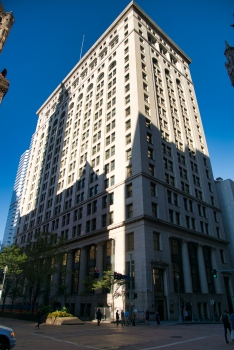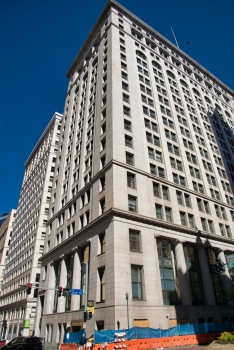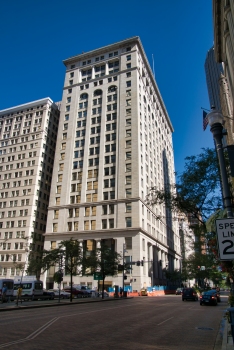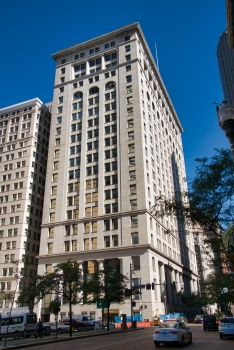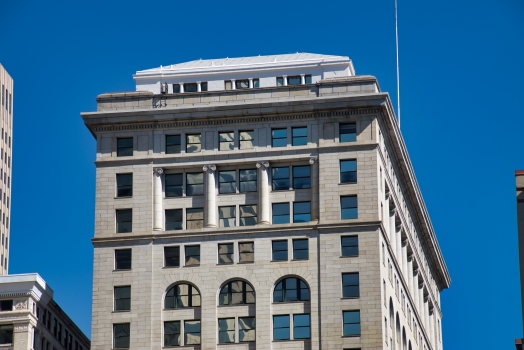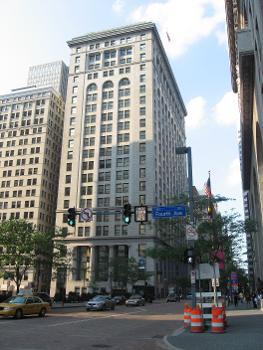General Information
| Completion: | 15 March 1902 |
|---|---|
| Status: | in use |
Project Type
| Function / usage: |
Office building |
|---|---|
| Material: |
Steel structure |
| Architectural style: |
Neoclassical |
Awards and Distinctions
Location
| Location: |
Pittsburgh, Allegheny County, Pennsylvania, USA |
|---|---|
| Address: | 437 Grant Street |
| Coordinates: | 40° 26' 20.96" N 79° 59' 50.37" W |
Technical Information
Dimensions
| height | 101 m | |
| number of floors (above ground) | 20 | |
| gross floor area | 33 210 m² |
Cost
| cost of construction | United States dollar 2 000 000 |
Materials
| building structure |
steel
|
|---|
Excerpt from Wikipedia
The Frick Building is one of the major distinctive and recognizable features of Downtown Pittsburgh, Pennsylvania, United States. The tower was built by and is named for Henry Clay Frick, an industrialist coke producer who created a portfolio of commercial buildings in Pittsburgh. The building is listed on the National Register of Historic Places.
The tower was built directly adjacent to a building owned by his business partner and rival Andrew Carnegie, on the site of Saint Peter Episcopal Church. Frick, who feuded with Carnegie after they split as business associates, had the building designed to be taller than Carnegie's in order to encompass it in constant shadow.
The Frick Building was opened on March 15, 1902 and originally had twenty floors. It was the tallest building in the city at that time. A leveling of the surrounding landscape that was completed in 1912 caused the basement to become the entrance, so some sources credit the building with twenty-one stories. It rises 330 feet (101 m) above Downtown Pittsburgh. Its address is 437 Grant Street, and is also accessible from Forbes and Fifth Avenues.
The building's architect was Daniel H. Burnham of D.H. Burnham & Company, Chicago.
The top floor includes a balcony around the perimeter of the building, a high, handcrafted ceiling, and heavy, elaborate brass door fixtures. Originally, H.C. Frick used it as his personal office and as a meeting place and social club for wealthy industrialists. On the 19th floor was Frick's personal shower. At the time, no other shower had been built that high above ground level, because water could not easily be pumped that high with the technology of the time. The shower, non-functioning, still exists on the 19th floor today.
Fittingly for a building created for a man who vowed to be a millionaire by age thirty, the lobby features an elegant stained-glass window by John LaFarge, depicting "Fortune and Her Wheel" (1902). The two bronze sentinel lions (1904) in the lobby were created by sculptor Alexander Proctor. A bust of Frick by sculptor Malvina Hoffman (1923) is displayed in the rear lobby, which extends from Forbes to Fifth Avenue.
For a time, the building was home to the headquarters for Frick's family whiskey business, Old Overholt. The headquarters oversaw a network of sales offices around the United States.
Text imported from Wikipedia article "Frick Building" and modified on July 23, 2019 according to the CC-BY-SA 4.0 International license.
Participants
Relevant Web Sites
- About this
data sheet - Structure-ID
20026331 - Published on:
20/02/2007 - Last updated on:
26/09/2019

